PREFACE: This is a story about Change…about the transformation of a small part of the American Southwest. It’s about what happened to my old home town of Moab and what may happen next, just 55 miles south.
Some say that ‘the Future has not been written.’ I hope that’s true…JS
BORG (n) : a cybernetically-enhanced race which forcibly assimilates other sentient species into its structure and hive-mind.
It was never really about the bicycle. The contraption was merely a conveyance, a delivery system for a culture and a mind set and an industry that, even twenty years ago, was inevitable. The sport of mountain biking appeared in Moab in the mid-1980s. Within a decade, the amenities/tourist demographic had established a death grip on my old hometown. We had once been an eclectic mix of miners, ranchers, small-town businesses, government staffers and young hippie/back-to-the-earth types; now we found ourselves in a state of rapid transformation–of upheaval.
Suddenly it was as if those of us who had lived there no longer had a say in our own future. Out-of-town investors with the assets and capital to exploit Moab’s new moniker as “Mountain Bike Capital of the World” laid claim to its future. Like a Borg…for lack of a better word, a Bike Borg…opposing “the hive” was not an option.
Some of us resisted, though our own contradictions marginalized our effectiveness. I had started The Zephyr in 1989 and, though I made a real effort to present ‘both sides’ of any argument on environmental or economic issues, my loyalties still resided with mainstream liberal environmentalists, who I believed were dedicated to preservation and protection of this remarkable canyon country landscape for the most honorable of reasons.
READ ‘NEW WEST BLUES’ FROM 1993: http://www.
By the mid 1990s, I began to have doubts. As the ‘green’ movement made great concessions to the tourist and recreation industry and embraced and promoted the economic advantages of wilderness designation, the dramatic impacts of a recreation economy became unmistakably obvious. Environmentalism, in fact, became an industry unto itself, with huge budgets, even among the ‘grass roots’ groups like SUWA and the Grand Canyon Trust. Some of the richest industrialist/financier/capitalists threw their resources and expertise (and their votes as board members) into these organizations. By 2001, it was all over but the shooting. Resistance to an overwhelming, one trick pony economy was futile.
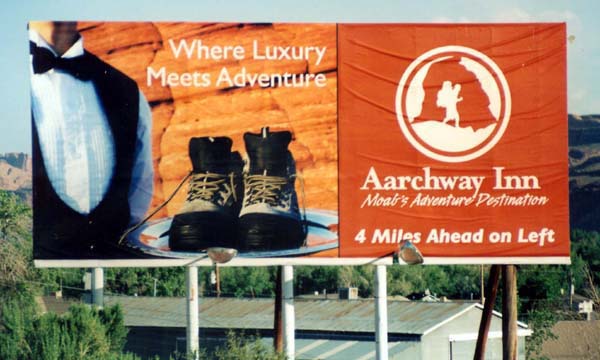 I further marginalized my own publication when I continued to oppose the Bike Borg. Advertisers fled. New Moab businesses, with no interest in ‘saving’ a town that had no meaning to them before they arrived, held my opposition in dubious regard. And of course, what new tourist business would want to advertise in a newspaper that didn’t want them to come in the first place? I could hardly fault them.
I further marginalized my own publication when I continued to oppose the Bike Borg. Advertisers fled. New Moab businesses, with no interest in ‘saving’ a town that had no meaning to them before they arrived, held my opposition in dubious regard. And of course, what new tourist business would want to advertise in a newspaper that didn’t want them to come in the first place? I could hardly fault them.
Realizing I could no longer reside there, I fled with The Zephyr to Monticello and for the next decade ran my little rag from the laundry room of my home. Monticello is a small monolithic Mormon town with a disdain for Moab and all things ‘touristy.’ Their mantra is “We don’t want to be the next Moab.” So it seemed like a good place to hide out. I thought I was safe there. And in most regards it’s still a far cry from the madhouse up the road.But it’s only 55 miles. And it’s December 2013…The Bike Borg is watching. IT’s coming.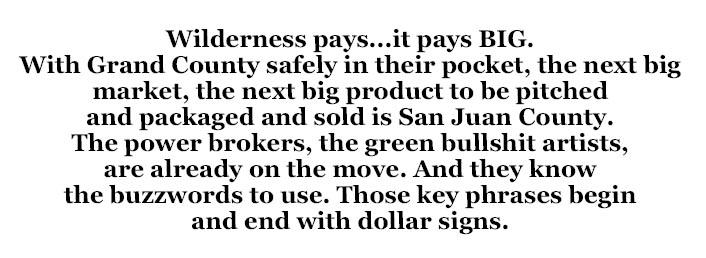 San Juan County has never been a bubbling bastion of enthusiasm for tourism, the recreation industry or any business attached to the legal designation of wilderness. Its hostility toward non-motorized activities like backpacking is almost legendary. It has exhibited an almost pathological loathing of environmentalists and wilderness groups like SUWA.
San Juan County has never been a bubbling bastion of enthusiasm for tourism, the recreation industry or any business attached to the legal designation of wilderness. Its hostility toward non-motorized activities like backpacking is almost legendary. It has exhibited an almost pathological loathing of environmentalists and wilderness groups like SUWA.
I still recall a cartoon that the now defunct Elk Ridge Café in Blanding once proudly displayed by its cash register. It depicted a group of cowboys on the phone to a green group in Salt Lake who was, even 25 years ago, pushing for a wilderness bill.
“Sure,” the cartoon caption read, “Come on down. We’d love to talk.” Each of the cowboys was holding a rope fashioned in a hangman’s noose.
Decades later, anti-wilderness sentiment still burns strongly. Even scaled down proposals for congressionally mandated wilderness designation meet stiff resistance. Few in San Juan County want any wilderness at all. The more pragmatic among them, including some of its more prominent politicians, believe some kind of compromise is inevitable. Others are practically ready to wage war on the federal government. Literally. The fear among most San Juan County residents is that the passage of wilderness legislation and the associated application of restrictions will further limit open access to public lands.
For me, the fight for wilderness has always been a moral and ethical issue. If setting aside the last remnants of God’s creations was meant to be a selfless act to save those lands from human intrusions–if our real goal was to say, ‘Let’s leave some of this beauty ALONE—for its own sake, NOT for ours,”– then anti-wilderness people and I would be worthy adversaries. I have no problem defending the idea of protecting the rocks, the trees, the critters and the blue skies above, with no expectation of personal gratification.
Some might think that’s a foolish and wrongheaded and impractical folly. They associate open access to public lands with the unshakable belief that to block access is a fundamental challenge to personal freedoms and a denial of the liberties set forth in the Constitution. And they sees it as a massive intrusion of the federal government.
But protecting these kinds of lands from further exploitation, for ANY purpose, be it energy extraction or industrial tourism, is evidence that we humans can make sacrifices for the good of the planet. That we can still make gestures that are not self-serving and that we can “do good things” with no regard for enhancing the size of our wallets, the balance in our checkbooks, or quenching our insatiable thirst for more ‘stuff’ via its commodification and sale. It tells us we can be noble altruists in the purest sense of the word.
Or consider this take on wilderness, from a source usually loathed by the anti-wilderness crowd. More than forty years ago, in a world so different from today as to almost be unrecognizable, Edward Abbey wrote about the need for wilderness and offered this unique suggestion:
“The wilderness should be preserved for political reasons. We may need it someday not only as a refuge from excessive industrialism but also as a refuge from authoritarian government, from political oppression. The Grand Canyon…may be required to function as a base for guerrilla warfare against tyranny.”
Oh the Irony. Almost half a century later, Abbey’s rant sounds more like a passage from a Tea Party Survival Manual; yet, one would be hard pressed to find a Utah Tea Party member willing to support even one acre of congressionally-mandated legislation to designate “wilderness.”
In the last days of 2013, those kinds of honorable and noble reasons for protecting what remains of America’s wildlands are lost in the rush to turn every facet of the land into an industry—a money machine. Environmentalists condemn the “extractive industries”—mining, ranching, logging, energy exploration–and devote their energies to stopping the damage such industries inflict. Yet, they scarcely acknowledge the most destructive industry of all. Words like “reverence” and “silence” and “solitude” are lost from the ‘green’ lexicon. Wilderness is now exploited for profit as surely as it were gold and silver. Somehow extracting the very heart and soul of the land itself meets little resistance from the same people who once admired and respected the likes of Wallace Stegner and Wendell Berry and Ed Abbey and John Muir.
They will laugh and make the argument, “Surely you’re not saying a bicycle is as destructive than a bulldozer!” Well..not exactly. A tourist’s direct imprint, no matter what the conveyance, is not nearly as impacting as a CAT D-9. Where they fail to connect the dots and fail Reality itself is the fact that the tourist/amenities economy requires the massive consumption of natural resources and energy to even exist. It requires an exodus of people from urban areas to small remote towns. It demands, in fact, the urbanization of the rural west. This is environmentalists’ Achilles Heel.
It was, after all, the Grand Canyon Trust’s Bill Hedden who once proclaimed, “Industrial-strength recreation holds more potential to disrupt natural processes on a broad scale than just about anything else.” Twenty years later, Hedden and the Trust and other “green” groups seldom talk about the recreation menace. Now, turning wilderness into a cash cow is a favored strategy, not a shameless exploitation.
Wilderness pays…it pays BIG. With Grand County safely in their pocket, the next big market, the next big product to be pitched and packaged and sold is San Juan County. The power brokers, the green bullshit artists, are already on the move. And they know the buzzwords to use. Those key phrases begin and end with dollar signs.
And while rural Westerners worry about reduced access to public lands, or whether their favorite jeep trail is about to be closed, the most potent and irreversible threat to their very existence is knocking at the backdoor. It’s the loss of the rural values that most residents of San Juan County cherish, and the creation of an urban population center that bears little resemblance to the place you call home today. Already, the Borg has a secure toehold and few if any seem to realize it. A toe today. Your soul tomorrow.
*******
Ashley Korenblat’s Amenities Dream Scheme…
NOTE: In this section of the story we frequently quote Ms. Ashley Korenblat of the ‘Utah Outdoor Business Network’ during a presentation to the San Juan County Commission on June 10, 2013. We transcribed verbatim an audio recording of that meeting and provide several direct quotes here. The complete audio can be heard at:http://www.sanjuancounty.org/
In some ways, conservative Westerners are their own worst enemies. They have always been torn by two very conflicting, incompatible philosophies. On the one hand, Old Westerners, especially in Utah, have resented us ‘newcomers.’ They have never wanted our advice or felt they needed it. We are as alien to them as a Martian landing on the White House lawn.
“We don’t need you to tell us how to manage our lands.” It’s a refrain repeated again and again. You’d think nothing could shake that resolve. But something can. Those same independent Westerners, who loathe the sight of an Outsider are simultaneously dyed-in-the-wool capitalists right up to their eyeballs. They never see a money-making project they don’t like. They cannot resist a good deal and, too often, it’s the short-term profit that blinds them to the bigger picture.
San Juan County has danced around the edges of a tourist economy for years. Twenty-five years ago, I would never have dreamed that someday Blanding, Utah would call itself, “Your Base Camp to Adventure” and stick that logo on their “Welcome to Blanding” road signs. I wonder what the late Cal Black might think of that. Still the changes are in their infancy. A few shops have popped up here and there, eager to embrace the Borg. But for the most part, San Juan County has held its enthusiasm for a full-blown tourist/amenities economy in check.
In 2014, the “green business community” of Southeast Utah, with headquarters firmly rooted in the Moab success story—the people I call “enviropreneurs”—are ready to sell San Juan County a bill of goods that, if successful, will leave today’s San Juan County residents as bewildered in 20 years as Moab’s residents of 1993 are now. It can happen fast. Faster than you can imagine. The refrain in Monticello today is, “We don’t want to be another Moab.” Someday you could be asking, “How did we become Moab?” It’s not as unimaginable as you might think.
Last summer, representatives from an organization called the Utah Outdoor Business Network (UOBN) appeared before the San Juan County Commission to make their case for a dramatically expanded tourist economy and to discuss a letter they had sent to Congressmen Bishop about wilderness designation in eastern Utah. Ashley Korenblat, Jason Keith, Vaughn Hadenfield and Jeff Barrett, all enthusiastic recreation boosters with decades-long vested roots in tourism, shared their unbridled enthusiasm.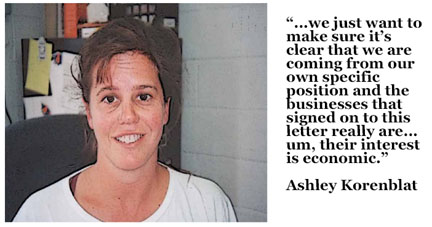
Korenblat, the chief spokesperson, made a pitch to those capitalist instincts when she told the commissioners, “…one thing that I want to make clear is that we’re not the conservation community…Our viewpoint, our interest, really derives from recreation and the businesses associated with that right now. We may share some interests with the conservation community on conservation in certain areas. But we just want to make sure it’s clear that we are coming from our own specific position and the businesses that signed on to this letter really are…um, their interest is economic.”
She added, “All we’re doing right now is trying to stake a claim, or at least articulate the places that matter to outdoor recreation…….a reflection of their interest in optimizing the landscape and trying to protect the assets that these businesses rely on.”
Korenblat offered examples of ways San Juan County is missing out on tourism dollars. She noted:
“When recreation is not managed, and it kind of happens haphazardly and evolves over time, you end up with issues like the fact that Indian Creek (which) is a world class climbing area, but the way it works, and the way people visit, there’s nowhere for them to… they don’t spend their money in San Juan County. They either load up their car in Colorado or… And this is same way with motorized recreation and lots of other types of recreation, where the people are relatively independent. The question becomes, if San Juan County starts to move in the direction of developing the recreation economy here, that’s one of the things that needs to be addressed is you want to make sure that the recreation assets are placed in such a way.”
And there’s the problem the way Korenblat and company see it; there are plenty of natural “assets” for recreationists to enjoy, but not the business infrastructure to take advantage of it.
Korenblat explained, “You’ve got to advertise to get people to come and to encourage people to start the businesses, but unless the business is there. (sic) Unless the restaurants and grocery stores and hotels are there, then you don’t really see the revenue. It’s hard to see the benefit of the advertising. So it’s sort of this thing that has to evolve… Like, it’s just pure entrepreneurship. Like, people that want to start businesses, and want to bring people here. And what we’re seeing is, there are a bunch of entrepreneurs in San Juan County that are working on it. That are starting different outfitting businesses and restaurants and really look at, gee, this is a beautiful place. Lots of people want to come here. I want to live here. How can I make a living here. so there’s a whole bunch of dots. Its’ definitely not a linear process.”
Korenblat proposed one way to cash in on the popular climbing destination in Indian Creek… “The problem,” she explained, “is San Juan County is seeing the impacts but it’s not capturing any of those dollars down there, that drive right through your county and use your world class landscapes. I think that’s a big challenge. If there were some incentive for them to stop here in Monticello and buy their groceries…You ought to open a convenience store there at Church Rock. I think he would seasonally, make it hand over fist.”
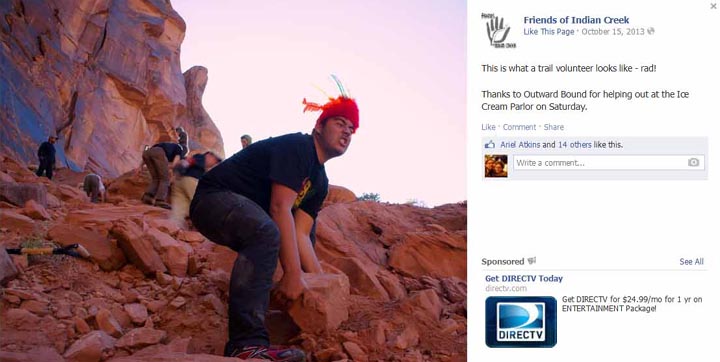 The county commissioners asked the group if they supported a proposal to create Greater Canyonlands National Monument.” Korenblat answered, “No.”
The county commissioners asked the group if they supported a proposal to create Greater Canyonlands National Monument.” Korenblat answered, “No.”
But then she dissembled :
“The outdoor industry, nationally, is concerned about this area. Part of it is, every product that those companies make can be found around here being used, pretty much everyday. So they have an interest in the area and the way that they usually function with regard to public land has been to just do whatever the conservation community says. So as a business person you’re doing your job,…the conservation community says hey, did you know there was a threat to the landscape? You’re like, no, what’s going on? They say, well, you’ve got to sign this letter, or go to this meeting, or write a check, or whatever. And you’re pretty much like, ok… you haven’t had time to research it. So the purpose of the Utah Outdoor Business Network is to make it possible for business owners to know what’s going on, and for the businesses to speak with their own voice. There may be overlap with the conservation community. There may be overlap with other groups. But that voice, of the pure business voice, hasn’t really been there.”
A couple months later, in an interview with Greg Hanscom for a story in ‘High Country News’ called ‘Stakeholders,’ Korenblat stated, “Wilderness is a good tool for protecting that land in its natural state.”
None of us can have it both ways. And her support for Greater Canyonlands was enough to generate a rebuttal from Grand County Council commissioner Lynn Jackson. In the HCN story Korenblat explained, “Folks in the rural West see kids in Grand Junction driving trucks for Halliburton making $80,000 a year. They see these jobs as good jobs, but they aren’t going to last. (Utah Republican Rep. Jason) Chaffetz has said, ‘We wouldn’t want to do anything now that would prevent us from getting high-paid extraction jobs in the future.’ Actually, you might. Look at the loads of people leaving Salt Lake City to move to Moab.”
(A Rebuttal to the OIA / Ashley Korenblat Statement on the Proposed Greater Canyonlands NM.
http://sagebrushcoalition.com/
At the end of the day and regardless of the contradictions or the artful dodging, Korenblat and her friends are clear about one thing. As she said, “It’s just pure entrepreneurship.”
What does that mean for San Juan County? All you have to do is look 55 miles north. Because what Korenblat and others are proposing is straight out of the New Moab playbook. Those “loads of people” moving to Moab that she refers to have been making the pilgrimage for 20 years. And hardly any of them had or has an interest in the town before they got there.
 Moab didn’t become the town it is today because the people who lived and worked there decades ago wanted it this way. Few in Moab had the capital and the resources to transform the community so drastically in such a relatively short time. Money (and the power that goes with it) came from elsewhere. From Park City and Telluride and from California. From just about everywhere but itself…Moab’s future was decided while most of its residents sat on the sidelines and watched.
Moab didn’t become the town it is today because the people who lived and worked there decades ago wanted it this way. Few in Moab had the capital and the resources to transform the community so drastically in such a relatively short time. Money (and the power that goes with it) came from elsewhere. From Park City and Telluride and from California. From just about everywhere but itself…Moab’s future was decided while most of its residents sat on the sidelines and watched.
Whether Monticello and San Juan County face a similar fate is anybody’s guess. But at least this time around, you should know what might be coming…
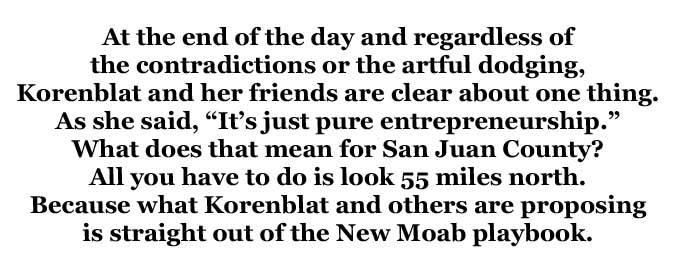 In this episode: “Totes Awesome Monticello?”
In this episode: “Totes Awesome Monticello?”
When Ashley Korenblat and the Utah Outdoor Business Network appeared before the San Juan County Commission last summer to pitch a dramatically expanded tourist/recreation economy, she explained it was “all about entrepreneurship.” She talked about lost tourist dollars in San Juan County and lamented, if only “there were some incentive for them to stop here in Monticello…”
And there’s the rub.
Why DO tourists prefer to drive all the way back to Moab for the evening rather than stay or stop or even slow down when they zip through Monticello? We all know the answer to that—it’s the amenities Moab has that Monticello doesn’t. It’s the plethora of motels and bed & breakfasts and restaurants and cafes and brew pubs and yupster bars and bike shops and bike rentals and zipline companies and climbing gear stores and BASE jumping guides and slackline parks and river companies and canyoneering companies and Adventure tours and Adventure motels and Adventure stores and curio shops and T-shirt shops and yoga shops and massage therapists and aquatic centers and private gyms and personal trainers and life coaches and nightly condo rentals and wineries and spas.
As the marketing people might say: “…and SO MUCH MORE.”
Monticello has a nice grocery, perfectly suited for the population that now lives there, a fine mercantile store and a good drug store and several reasonably priced places to eat. It has a (relatively) new Maverik Store that serves soft-serve frozen yogurt. And its biggest tourist draw is the LDS mini-Temple.
In fact, Monticello lacks almost all of the ‘amenities’ that makes Moab, well, Moab.
To use the vernacular and marginalize a once significant and meaningful word, Moab is “Epic.” Monticello is not. It is Epic-less. Monticello is Epic-free. It lacks Epic-ness.
The question is, how badly does Monticello (and Blanding and all of San Juan County) want to be the next Totes Awesome New West town? Does it long to be Epic? Because when Ashley Korenblat talks about a more vibrant recreation economy in San Juan County, when she enthuses about the kinds of businesses that would encourage climbers from Indian Creek to turn south instead of north at the end of a thrill-packed day, this is what she means. It’s about transforming a rural Utah Mormon town into something more palatable to the same people who now make Moab their real “base camp to adventure.”
 Like Moab, if Monticello is to change, it will be pushed by outside money. For the most part, its citizens don’t have the resources and capital to make huge investments in a massive make-over. For example, the soon to be constructed multi-million dollar Four Corners School ‘Canyon Country Discovery Center’ was an idea first embraced by local citizens. But the money to make it happen won’t come from the local citizens.
Like Moab, if Monticello is to change, it will be pushed by outside money. For the most part, its citizens don’t have the resources and capital to make huge investments in a massive make-over. For example, the soon to be constructed multi-million dollar Four Corners School ‘Canyon Country Discovery Center’ was an idea first embraced by local citizens. But the money to make it happen won’t come from the local citizens.
Bill Boyle, one of the architects and supporters of the CCDC (and the editor of the SJR), and I have had some lively conversations over the project these past few years. I’ve come to regard Bill as one of my best friends and to appreciate the fact that he and I can have differences of opinion, express them freely, and without fear of the argument turning rancorous; the fact that he published this essay in his newspaper is testament to that kind of open dialogue.
Years ago, Bill saw the Discovery Center as a way to help a floundering economy and add some diversification to the town’s business community. It’s a sentiment and an economic strategy often embraced in small rural western towns with shrinking populations and sliding economies. What most proponents fail to grasp, until it’s too late, is that these kinds of economic infusions rarely help the citizens they are intended for. Economic development should primarily assist the people who already live in that town. Chambers of Commerce should first and foremost be looking after their own, not seeking new competitors for their own members.
When a local debate broke out about the CCDC in 2012, some wondered if there weren’t a hidden agenda and questioned the motives of its executive director, Janet Ross. After all, she was once a SUWA board member herself. Some insisted that her secret plan is to push a wilderness agenda that would restrict access to more public land. The San Juan Record’s Buckley Jensen responded, “Janet Ross is far more the shrewd fundraiser and businesswoman than she is the wild-eyed environmentalist bent on shutting down everything in San Juan County.”
Buckley is absolutely right. What few residents of southeast Utah realize, whether they are pro-wilderness or anti-wilderness, is that the issue of legislative ‘wilderness’ itself, in 2014, has little to do with some passionately held ‘cause.’ “Restricting access” is no longer a moral issue; it’s not an honest attempt to protect what remains of southeast Utah’s wildlands in order to spare it from future development and destruction. Wilderness is now about how it can make money for the people savvy enough to “invest” in it. It’s about replacing one kind of extractive economy with another. Wilderness IS money now and has little meaning to anyone beyond that.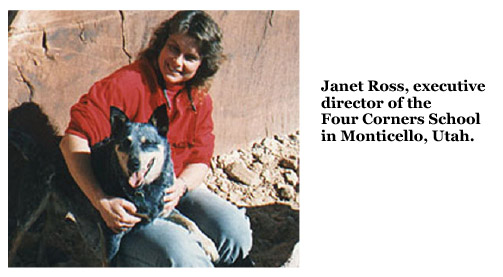
As Ross said in 2012, the CCDC will, “produce an estimated potential Social Return on Investment of $9.8 MIL annually (based on the monetized social value of all teacher retention and renewal programs, student education/motivation programs, professional certification programs, workforce development/youth employment programs, and scientific research for San Juan County & the Colorado Plateau.”
Not much “wild-eyed” wilderness poetry in that statement.
“Clearly,” she concluded, “this facility will draw visitors to the City of Monticello and its businesses, and is meant to be an economic driver for all of us.”
In other words, Ross offers the Discovery Center as a financial opportunity to anyone who wants to climb aboard the fast-moving engine of a tourist/amenities economy. It’s an engine that could be an integral part of transforming Monticello and San Juan County. But whether it will benefit “all of us” is questionable. There is an assumption that visitors to the Discovery Center will require many more ‘amenities’ than Monticello can currently provide. The reality that goes with it is, if the local citizenry can’t provide them, the new amenities must predominantly come from elsewhere. And they will.
For the Discovery Center to become a reality, much of its funding comes from the same wealthy benefactors that keep organizations like the Grand Canyon Trust and the Southern Utah Wilderness Alliance flush with cash. When the Four Corners School became an active participant and driver of the CCDC, Ross knew how to bring in money in ways other locals would never imagine. Recent major contributors, according to the CCDC’s web site, include billionaire Hansjorg Wyss, who sits on both GCT’s and SUWA’s board of directors. He has provided significant funding, (reportedly $2 million). Venture capitalist David Bonderman, a billionaire who recently spent more than $10 million on his own 70th birthday party, added his own generous donation. He also sits on the board of directors of The Grand Canyon Trust and is a major SUWA financial backer. Other multi-millionaires with roots in Moab and longtime supporters of mainstream green causes have tossed some of their largesse into the CCDC pot as well.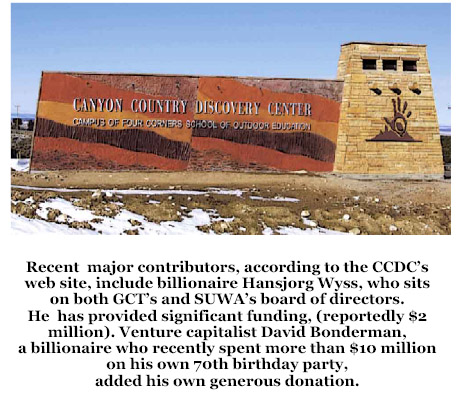
The list of Four Corners School/Discovery Center 2013 ‘gear sponsors’ sounds like a roll call of Outdoor Industry Alliance (OIA) members, including: Adventure Medical Kits, All Terrain, Alpine Aire Foods, Backcountry.com, Black Diamond, Camelbak, Carhartts, Camp Chef, Clif Bar, Columbia, Crazy Creek, Don’t Go Nuts/Pinto Barn, Eureka, Falcon Guides, GSI, GU, Hanes/Duofold, Hi-Tec, Honeystinger, Hyalite, Jansport, Kahtoola, Katadyn, Keen, Kelty, LaraBar, Mountain House Foods, Mountain Khakis, Mystery Ranch, Osprey, Patagonia, Petzl, Princeton Tec, Polar Bottle, Red Ledge, Sea to Summit, Smart Socks, Smartwool, Stage, TEVA, Timberland, and Travel Chair.
Yet the letter that ignited the recent controversy over the “Greater Canyonlands” proposal was, in fact, from the OIA—a letter that Korenblat vainly tried to distance herself from when she addressed the commissioners. The same people pushing the Greater Canyonlands plan are simultaneously dedicated to seeing CCDC work. Why? Is it possible to believe that billionaires like Hansjorg Wyss and David Bonderman or OIA sponsors like Black Diamond and TEVA have the best interests of rural San Juan County in mind and heart when they dump money by the truckload into this project?
No. What these benefactors want, and what most people who embrace a New West Amenities economy to fuel its future want, is the same kind of demographic change that happened in Moab. This is about changing the social fabric of a small town from one that is essentially rural and conservative to a more “progressive”/mainstream “green” New West population center. It’s that simple.
Finding Consensus with Ed Abbey & Brigham Young…
So…what would Monticello look like if urban enviropreneurs were as successful as they’d like to be? What would a suddenly booming tourist/recreation economy do to San Juan County and the residents that live there now? Imagine the changes in real terms.
New businesses would mean more infrastructure and extra work for contractors, plumbers and electricians, though once the word is out, new faces in these fields would come as well, creating more competition. At first, retail stores would see a dramatic increase in sales—the grocery, the mercantile, the drug store. Motels and cafes. But again, competition for increased business would play a role here…as the expanded ‘tourist pie’ gets carved up, and more businesses come to compete for it, the slices would shrink. Soon businesses would complain that their slice is too small. That they need a bigger pie. That means more funds for tourist promotion and for more “amenities” to draw them.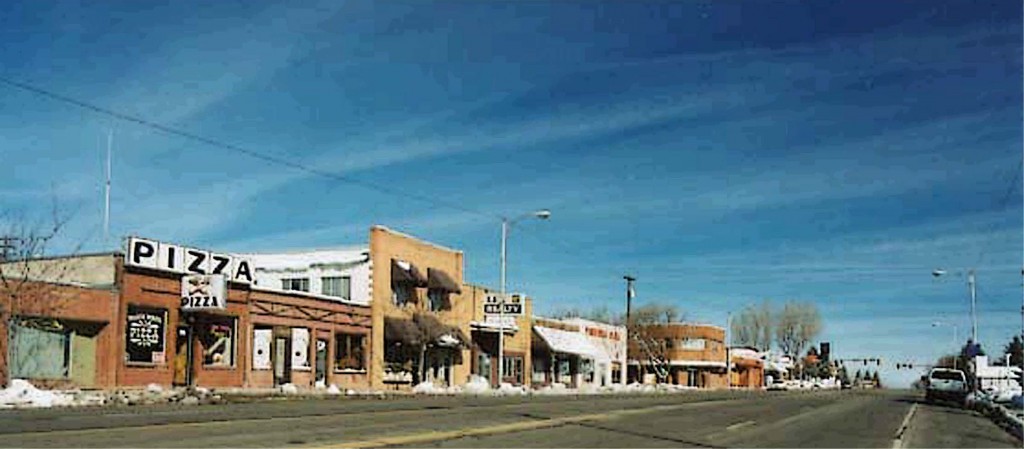
Expect more motels, more espresso shops and restaurants. Assume that eventually, the local government will acquiesce to the need for some kind of bar or brew pub. Franchise restaurants will finally see a viable reason to expand their markets and small locally owned restaurants will suffer for their arrival. More people means a second grocery and a second drug store. Now that Moab has two weekly papers, Monticello’s more conservative San Juan Record could face a similar challenge.
As the boom grows and Monticello gains cachet, as it assumes its role as the next ‘New West’ town, the value of homes would increase, perhaps quickly. For those who just want to sell and get out, skyrocketing prices make for good investments. They’re not so great for people who want to keep calling Monticello home—appraised values would jump and so would property taxes. As the market for existing homes dries up, a push for new housing would follow. Open fields and agricultural areas adjacent to the city would rise exponentially in value, making it difficult for the current owners to resist selling. Those who choose to hold onto their lands would also face huge tax increases.
Local residents might be surprised to see a new level of cooperation between the non-motorized recreation community and the BLM in San Juan County. At a September 2013 public meeting in Sedona, Arizona , Grand County Trail Mix trails coordinator Scott Escott bragged about his organization’s extraordinary success in constructing new single track bicycle trails on public lands near Moab. He pointed to more than a decade of work, “building trust” with the BLM. “And now we have another line of trust,” Escott proclaimed. “What Trail Mix has gained from this is that the BLM defers to us when it comes to the actual trail building. They trust us and do not question us on trail alignment and construction. This trust is the basis of our partnership.”
Escott noted that their biggest critic at BLM, Katie Stevens, had observed their trail construction. According to Escott, “Katie called it the Appian Way, after the work of the ancient Romans which still exists today.” He could not have been prouder. Will that kind of enthusiasm lead to similar single-track/bike-only trails in San Juan County?
I’ve never liked the idea of giving ANY special interest recreation group, whether they represented motorized or non-motorized interests, a blank check to plan and build trails of any kind across public lands. I’m sure my mainstream green friends have fought tooth-and-nail over the years to block what they perceive to be collusion between government agencies like the BLM and ATV organizations. Now, with the Bike Borg in Moab clearly claiming sovereignty to do as they please on public lands, at the very least, an entirely new kind of debate over public lands access and modification could lie ahead.
(For the full speech: http://www.fs.usda.gov/
Some will argue that Moab and Monticello are two very different critters and that to assume the same revolution that hammered Moab will strike San Juan County is a mistake. It is true, Moab has always suffered from a Boomtown mentality, while Monticello has clung to its insularity. And certainly Monticello’s long bleak winters could discourage many would-be investors. I used to think Moab’s incredible heat would be a deterrent to its growth. Who could afford to buy a second home and use it for a few weeks a year? But I was wrong. As it turned out there were plenty of buyers, especially when the prices were low, as they are in Monticello now. To assume that Monticello is too cold and too conservative and too isolated to experience a boom similar to Moab’s is to make the same mistake we made when we lived in Moab and thought it could never happen there either.
Whatever the impacts and the changes that may result, Ashley Korenblat and her allies at the UOBN insist that the high-paying jobs will come from a tourist/recreation-based industry. And to make her case she points to, “the loads of people leaving Salt Lake City to move to Moab.” But isn’t that the point? Her Grand Plan helps the “loads of people” who live elsewhere, who see an opportunity to cash in on what they perceive to be a depressed economy in San Juan County. And at whose expense? The people who already live here.
Ed Abbey once said, “Growth for the sake of growth is the ideology of the cancer cell.” And it was Brigham Young who noted, “Those who are covetous and greedy, anxious to grasp the whole world, are all the time uneasy, and are constantly laying their plans and contriving how to obtain this, that, and the other. . . . How the Devil will play with a man who so worships gain!”
Good to see Brigham and Cactus Ed on the same page…Sometimes it helps to stop and consider just how much ‘stuff’ any of us really needs to be happy. We say this town is depressed and that community is thriving. But what device do we use to make the measurements and draw conclusions? Must we always view wealth in dollars and cents? Do we ever look at its more intangible aspects? Brigham Young also noted, “Men are greedy for the vain things of this world.”
Monticello is not a perfect place to live. Its insularity can be exasperating and its politics as petty and self-serving as any other small town in the rural west. Every vice known to 21st Century humanity can be found there if you look hard enough. And, for crying out loud, even the grocery closes on Sunday! But for the vast majority of good and decent people who choose to live there, Monticello works. It works for them. It’s home. No, the town isn’t flush with ‘amenities’ and no, you can’t get a good Merlot.
Recently a friend argued that Monticello NEEDS changing. “It’s so backward,” he complained. “So…parochial.” Yes, I guess it is. But it’s their town. Those who hope to transform Monticello don’t do it out of some deeply held moral concern. They’re doing it for the money. And that, as Brigham and Cactus Ed note, is always the bottom line.
JIM STILES is co-publisher of the online Canyon Country Zephyr.
To read the PDF version of this article, click here ,here and here.
To comment on this article, scroll to the bottom of the page.
Don’t forget the Zephyr ads! All links are hot!

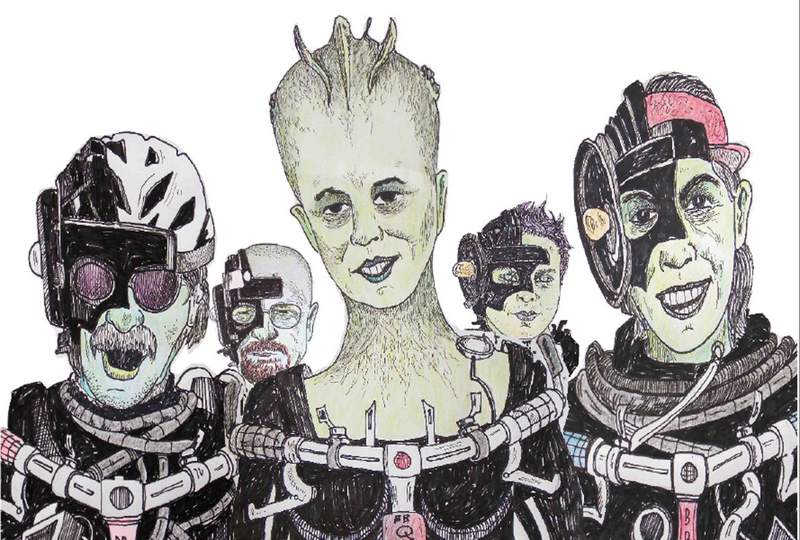

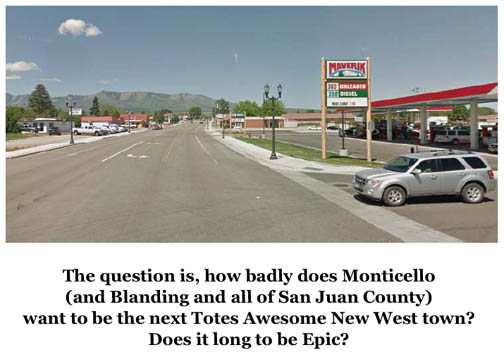
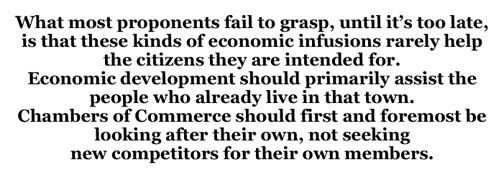
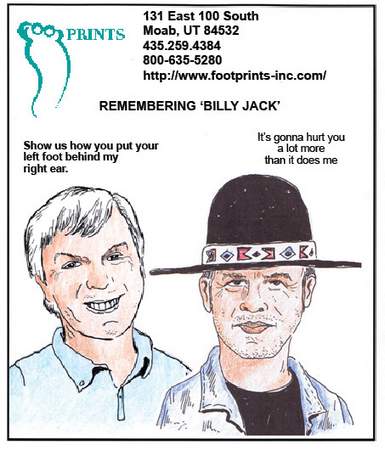
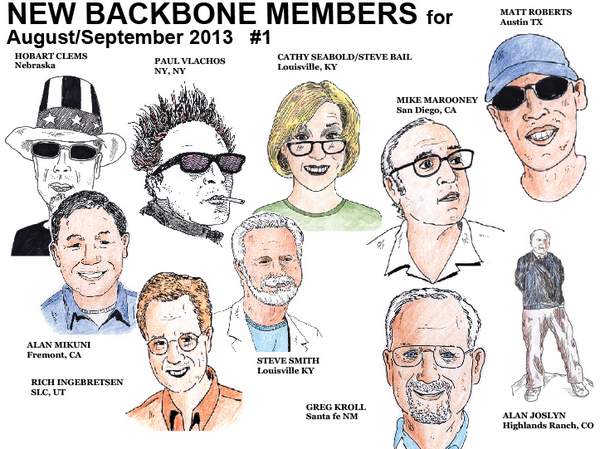
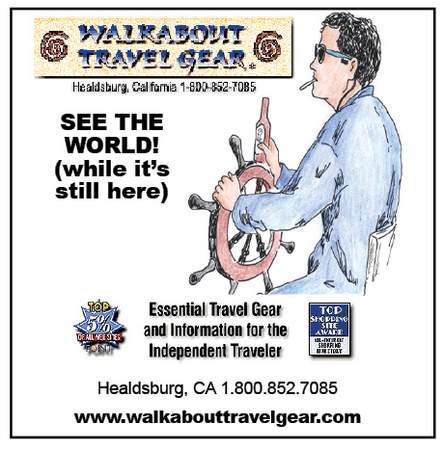

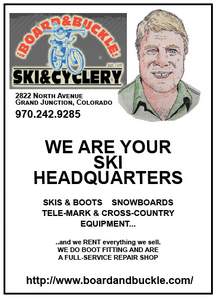
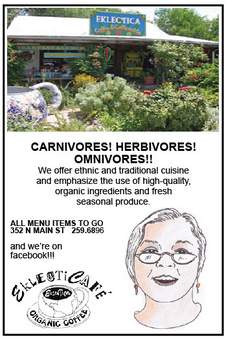

My young daughter plays a game called “Would you rather,” in which you take two things that may be closely linked and ask the other player which alternative they’d prefer to be. Grand and San Juan County residents will probably have to ask themselves, “Would you rather your town looks like the Bakken oil fields?” or “Would you rather your town looks like a tourist town?” Anyway, decisions by State Lands and BLM lands managers will dictate the destinies of these counties, not a bunch of informally organized recreationalists, the latter of which is the complaint of this article. Additinally, the elected officials in these counties are always going to look for ways to finance schools, hospitals, and other “essential” services, so they’ll be looking to the money, regardless of whether it comes with a mountain bike tire attached to it, or with the drill bit of an oil rig. I have heard that the closure of the uranium processing mill in San Juan County will remove $600,000 in taxes from the county pockets. What will they do to replace that money?
Greg…The issue isn’t either or. I’m not suggesting a ZERO tourist economy. You’re using Rush Limbaugh-esque hyperbole to make your point. Of course tourism can and will grow. BUT this kind of growth should benefit the people struggling to live there now, NOT drive them out and replace them. Do you want to help the people who are there, those rural Utahns that most environmentalists hold in such disdain? Or do you want to create a “New Monticello” cast in the image of people who love “New Moab?”
Also you write, “decisions by State Lands and BLM lands managers will dictate the destinies of these counties, not a bunch of informally organized recreationalists.” Did you read the story? Did you read Scott Escott’s comments? (“They trust us and do not question us on trail alignment and construction.”) And did you follow the provided link. Here is what Kim Schappert said about “informally organized recreationists.” (CAPS are hers)
“HOW COULD ANYONE HAVE EVER IMAGINED THAT THIRTEEN YEARS LATER WE WOULD HAVE A SOLID NON MOTORIZED TRAILS MASTER PLAN, AN EXCELLENT WORKING RELATIONSHIP WITH ALL THE LOCAL LAND MANAGERS, 100 MILES OF NEW SINGLETRACK AND A PAVED ALTERNATIVE TRANSPORTATION SYSTEM WORTH OVER 20 MILLION DOLLARS HERE IN GRAND COUNTY. ALL FROM A SCRAPPY BEGINNING, A SHOESTRING BUDGET, AND A CAST OF EVOLVING CHARACTERS THAT HAS CHAPERONED EACH STEP OF TRAIL MIXS WAY.”
Sounds pretty organized to me.
How anybody can reasonably expect Monticello to remain un-Moabized is beyond me. If Monticello “wants” to remain un-Moabized, as you indicate, they can take a lesson from Kremmling, Colorado. Just say no to all that stuff and remain “undeveloped”. Outsiders will say you have no amenities and that the town is ugly and tourists will just pass through on their way to somewhere else. Your place remains. The minute you make them stop and buy something, whether it’s food or gas or whatever, that’s when they look around and think what if? Don’t invite the “what if?” response.
okay, what do I know? I never thought they’d fill up the 30 miles between Denver and Boulder, but look at it now. Cripes.
“Same as it ever was” -Talking Heads
“We have seen the enemy….” -Pogo
“There goes the neighborhood” – Stiles, Abbey, inhabitants of San Juan County, Hopi as an Apache arrow sailed overhead, dinosaurs as rats clawed at their feet…….
“She still looks new to me, new and purty”
Jim, you say, “this kind of growth should benefit the people struggling to live there now, NOT drive them out and replace them.”
How do you propose that happen? Are you (or they) asking for handouts?
As freedom-loving free marketeers and personal responsibility preachers presumably they see their circumstances clearly. They should understand that if they want to leverage the assets of their community to improve their economic condition they need to practice what they preach and bootstrap it themselves. If someone else beats them to it, well, that’s the breaks. Right?
The reality is that ‘pulling yourself up by your bootstraps’ is something the other guy is supposed to do.
Side note – been reading you on and off since 1990. Always a pleasure.
Jim, It is reassuring to have you clinging desperately to the past. Come back some January and you will still find remnants of the ‘old Moab’: Main Street empty as far as the eye can see, mostly people one knows at the supermarket, people taking the time to chat with their cars in the middle of the street.
Let’s face it, there are just a whole lot more of us humans than there were even 40 years ago when we moved to Moab. Those with the resources will vacation or move to wonderful places, and some of those wanting to make a living will start businesses catering to them.
Meanwhile, I think you gave Ashley a bum rap. The quotes do not evidence any dissembling. Ashley is 4-square for business. She notes that conservationists and recreation business sometimes have shared interests, but not always, or even usually. She is all about preserving the land that makes recreating in and around SE Utah and the West unique. That’s not wilderness, but it’s also not Kansas.
Not sure why spending 10M on a birthday party is on its face evidence of anything except having a lot of money. Let’s see, David Bonderman is worth some 3 billion. That makes spending 10 million about 0.03% of his net worth. I don’t know what 0.03% of your net worth is, but for me that wouldn’t be much money at all: generous, but not wildly exorbitant for the big 70 celebration. And Las Vegas is not on anyone’s short list for wilderness designation.
(Disclosure, I sit on the board of PLS, Ashley and Jason’s consulting firm.)
Bob…Good to hear from you, though I think you might have had a better understanding of this article if you’d actually read it in its entirety, instead of just reading the pull quotes and MAPN’s interpretation of it.
It might have also been more helpful for our readers if you’d posted your disclosure at the beginning of your remarks, instead of at the end. You are on the board of directors of “PLS,” which stands for “Public Lands Solutions.” It is another non-profit lobby which, on its web site advocates for, “research and strategic advice on outdoor industry and public lands” and the “design and implementation of corporate programs on public lands.”
(http://publiclandsolutions.org/Home_Page.php)
RE: the ‘bum rap” I gave Ms Korenblat, I transcribed her comments, Bob, before the San Juan County Commission. They asked her if she supported the creation of “Greater Canyonlands National Monument.” She said, “No.” Then she went on to explain why she, in fact, does…sort of. I suppose she was dissembling when she said ‘No.’ I could also have used the word ‘backpedal.’
RE: Mr. Bonderman. If you ever read The multitude of stories this publication has offered about his ties to the “Green” movement and his actions as founding partner of TPG Capital, you might not be so uninformed. I will offer just two examples here (I don’t want to overwhelm you with facts) that might be more of a concern to you than the extravagance of his birthday parties…
EXAMPLE #1
The Southern Utah Wilderness Alliance recently posted an alert regarding energy development in Southeast Utah. Deeda Seed wrote, in part:
“The Western Energy Alliance – a consortium of energy companies and their partners (think Haliburton) – recently filed an appeal with the Interior Department seeking to overturn the BLM’s decision not to offer the leases. This, in spite of the fact that nearly 4 million acres of oil and gas leases currently exist on BLM lands in Utah, and less than 1.1 million acres are actually being used.”
But…One of the Alliance’s members is an energy development and exploration company called PETRO HARVESTER. It falls under the umbrella of the massive private equity firm TPG CAPITAL. Its founding partner and active executive is DAVID BONDERMAN. But Bonderman sits on the board of directors of the GRAND CANYON TRUST and is a major contributor to SUWA.
For a more complete account see: http://www.canyoncountryzephyr.com/2012/08/01/the-green-circle-that-eats-its-own-by-jim-stiles/
You support mainstream greens, Bob. In this ‘Green Circle’ story, I report how Petro Harvester caused the biggest brine spill in North Dakota’s history. Because environmental regs in ND are soft, they got off with a slap on the wrist…My question is, do you think green groups in Utah should feel that since the brine spill occurred in another state, that it’s okay to accept large amounts of cash to combat the SAME KINDS OF IMPACTS in Utah and Arizona? And if Petro Harvester operated on the Colorado Plateau, should these groups be more inclined to refuse large contributions from people like Bonderman? What’s your take on it, Bob?
EXAMPLE #2
Or how about this? Have you heard of ALEC? (American Legislative Exchange Council) This comes from Peaceful Uprising…
“ALEC produces model legislation written by corporations and major industry lobby groups, then dishes out these bills to legislators from around the country. Its annual meeting is coming up in the last week of July, and you can bet ALEC has some new tricks up its sleeve….”ALEC doesn’t only influence environmental policy, of course—it successfully pushes laws that suppress voter turnout, encourage racial profiling, and bust unions, just to name a few of ALEC’s favorite causes. But ALEC has done a tremendous amount of environmental harm with its dozens of anti-environmental bills….”ALEC’s Energy, Environment, and Agriculture Task Force—funded by groups as innocuous and environmentally concerned as ExxonMobil and the American Petroleum Institute, and co-chaired by American Gas Association—thwarts citizens’ democratic right to protect their health and environment.”
This comes from a past Zephyr story…
But here’s how complicated the ‘ALEC Issue” can be. Note that one of ALEC’s members is Energy Future Holdings, based in Texas. According to SourceWatch.org, “EFH is a member of the American Legislative Exchange Council (ALEC). Sano Blocker, an EFH lobbyist and Senior Vice President of Public Affairs, represents EFH on ALEC’s corporate board as of 2011.” (http://www.sourcewatch.org/index.php?title=Energy_Future_Holdings) The latest update from the Center for Media and Democracy (as of 7/26/12) states that EFH has not withdrawn from ALEC.
EFH is owned in part by TPG Capital, a massive venture capital company whose founding partner is David Bonderman. TPG is heavily invested in resource extraction around the world. (http://www.tpg.com/portfolio)
On February 29, 2012, “Occupy Dallas #F29–Shut Down the Corporations..National Day of Action” protested in front of Energy Future Holdings’ main office in Dallas, Texas. On its facebook page, one comment read: “How about a sign that says, ‘Energy Future Holding” are Kochsuckers…just a thought. LOL…but seriously.’ Yet the Koch Brothers, known for their conservative views and affiliation with the Republican Party, have nothing to do with EFH. Bonderman usually aligns himself with the Democratic Party..
http://www.canyoncountryzephyr.com/blog/2012/10/29/peaceful-uprising-a-l-e-c-complicated-adversaries-jim-stiles/
Do you have a problem with any of this, Bob?
Finally, had you fully read the Bike Borg story, you would have known that it was primarily about efforts to turn San Juan County into another Moab, NOT about Moab itself. That’s why I said Moab was “assimilated.” The time spent on Moab in this article constituted less than 10% of it.
I haven’t used the “Clinging Hopelessly to the Past” slogan in years, and mostly because some of your Moab ‘progressive’ compadres have tried to use it to portray me as a bigoted redneck. I’m sure that you know how untrue that is, that when The Zephyr was a print publication based in Moab, it was a champion of civil and human rights there and I personally spoke out against bigotry and racism when nobody else would. We intervened on behalf of single moms and gay rights and spoke out against attacks against inter-racial marriages. Still most New Moabites believe its history began on the day they arrived, and thus they have no knowledge or understanding of what happened there before.
It’s good to know Moab retains a bit of its old self during the winter months; if that’s enough for you, I can understand your sentiments. But you say that nowadays, “those with the resources will vacation or move to wonderful places.” The key word being “resources,” which is why Moab has become a more exclusive and expensive place to live. Some of the people in San Juan County, however, would like to have more than a few weeks a year to say their town is still theirs. And to be able to AFFORD to live there. THAT was the point of my story….JS
Wow, a 1,134 word response to a 271 word post. Never argue with somebody who buys ink by the barrel, or in this case web space by the MB. Oops. More later.
Bob..My job is to make all information available for my readers. Most of this was a cut and paste from previous articles that you must have missed. Happy Trails!
At 56 minutes 20 seconds in the audio of the San Juan County Commission meeting referenced in the article, the following brief exchange occurs:
Commissioner Lyman: I know the, you know the outdoor recreation industry [here he means the Outdoor Industry Association, the national group] was big in favor of the Greater Canyonlands proposal, and I know Ashley, you’re part of that – but is your, is this group [ie, UOBN, the Utah Outdoor Business Network] supportive of the Greater Canyonlands proposal?
Ashley Korenblat: No.
Jason Keith: The Monument, specifically?
Commissioners Adams & Lyman: Yes.
Ashley Korenblat: No.
At this point, Korenblat launches directly into her rationale for starting UOBN, which is that in the past, outdoor outfitters deferred to the conservation community without really knowing whether their business interests were being served by doing so. Korenblat says that UOBN was designed to provide outdoor businesses with info on public lands issues tailored to their business perspective.
Korenblat is indeed dissembling here. As a businessperson, she signed a letter in favor of the Greater Canyonlands National Monument, and wrote an extended letter explaining exactly why she supported it. Commissioner Lyman knew this, as evidenced by his question. Korenblat was extremely lucky that he didn’t ask her if her own business was supportive of GCNM. Her only honest answer would have been: Yes.
Korenblatt’s support for GCNM:
Why We Signed the Greater Canyonlands Letter
https://www.facebook.com/notes/western-spirit-cycling-adventures/why-we-signed-the-greater-canyonlands-letter/10151354575330242
Perhaps mountain bikers are more “Stepford” than Borg
They are eerily, all alike, acting and talking in the same manner. Their vacuous stares at you (or rather, through you) as you try to talk some common sense into them about their callous treatment of the natural environment, their own bodies, and their poor dogs (large and small breeds) who are run ragged trying to keep up with the bikes, inside and outside of our natural areas. These mtbers are oblivious to their dogs’ injuries, close calls with cars and buses. It is like they have become hypnotized, or turned into some kind of robot, that cannot make sense out of reality anymore, except to bow down to the mountain biking gods.
These mtbers almost superhuman endless trail digging and riding activities four seasons a year, rain, shine, sleet and snow is to be a cause for concern. You may have the Borg south of the Border, but I am thinking (from the many nonsensical answers I get from mountain bikers, and their supporters) that perhaps they are not human at all….!
Who is behind this wave of proliferating biker droids? The corporations and industry that drive this $$$ push for adventure/”eco” tourism?! Just another theory, from north of the 49th parallel, Jim…And they are coming after our children….
Read this with great interest. I was particularly struck by the convergence between Ed Abbey’s and Brigham Young’s viewpoints on greed.
Some people have a real knack for staying focused on the big picture come hell or high water and you’re one of them (that’s a compliment). Unfortunately, narrow self-interest or cynicism or both constrict all too many.
I especially liked the cartoon depictions….spot on! Is that Walter White in the background?
[…] […]
Hey I appreciate this conversation. I was an outfitter on the Upper Dolores river over here in Montezuma County (down right neighbors w/ Monticello). Soft Adventures Rafting was the name of my company. I got to operate for 2 years, to the great joy of everyone who got to float the river- many locals who grew up here had never been down the river until they came w/ us. Gave half day and “town run” raft trips, so folks could stay here instead of going to Durango or Moab to float. Operated in 2012 and 2013. Our customers bought groceries here, stayed in hotels, ate at the restaurants, drank at the pub, and loved our friendly little town. Then, a private landowner, tea party type, pro development (wants to dismantle the Dolores River Valley Plan, so private landowners can sell and develop), shut us down. He did so with threats of extortion- he said he’d “only” charge us x amount (thousands) to float by his place… He hired Richard Bratton, the lawyer who helped shut down rafting companies over on the Taylor river in Gunnison County, and so we rolled over and shut down… What’s the moral of the story? The anti-liberal types, tea party types, win. They shut down a “tourist” operation that was doing nothing but bringing in tourist dollars to the (depressed) local economy. Rafting is not biking- but you must know that over here in MC, mountain biking is trying hard. Rafting didn’t hurt the local environment (not gonna get into the production of the PVC and Hypalon rafts here however), but it does bring in tourists. When you’re talking about Monticello being Moabized, I think it’s not an “either/or” situation. What harms the environment, and does the local community want this type of development? Here in Montezuma County we have some rabidly conservative (pro develop the shit out of everything) types. Yet they shut down a rafting company and promote fracking. Go figure. I think the only solution is for everyone to be able to speak their mind, and be listened to, and for everyone to have an equal say. But it’s not that way. It’s really hard out here in the lovely rural west, which tends to let the tea party types take office. Meanwhile most of my “liberal” friends don’t want to get invovled. They’d rather be hiking, or skiing, or going to a festival, or…. I think the true tragedy is that so many of us “liberal” types don’t get involved. Too many are too busy enjoying the lovely environment while we still can… Next door the other way (San Juan County CO) we have Art Goodtimes as a green party commissioner. I only wish that all of our four corners wilderness canyon and mountain country politics could be democratic and respectful, and have political leaders who represent us all. Meanwhile, the frackers are coming in, the four wheelers protest the Forest Service attempts to protect the land, the archaeologic monument director allows frackers, and what seems to trump everything is money. Let’s create a new system. Keep up the good work!
The age of eco tourism is spreading and will consume San Juan like it has Grand County. The locals will adapt or perish if they wish to remain. Your comments are spot on about what was, what is, and what will be. Here in Moab we try to cling to our roots but it is difficult. The difference between us and them is we are willing to share. Not so with them. They come and tell us everything needs to be protected. Wilderness proposals are made, monuments created, and then the ecocrats move in and take over.
I’m an Arizonan who lives in Oregon. In the Pacific Northwest we’re debating about breaching dams to bring back the salmon and steelhead. It’s a tough issue as some people end up losing irrigation, tax base and cheap energy. I see you are worried about being inundated by mountain bikers. A worthy cause. I explored some of Abbey country in the 70’s. We went into Arches in the evening. No one there. Took our sleeping bags and hiked up to Delicate Arch. Another time we hiked into Bryce in the moonlight and camped. No one there. Zion was a few picnic tables. It’s obviously different now. Abbey’s vision of Industrial Tourism has come to pass. I still enjoyed hiking in all these spots. Moab was pretty low key in December. I used to get Outside magazine, until it dawned on me that the bulk of the print was either direct or indirect advertising and promotion, all using the same industry babble like “jaw-dropping.” I’d like to see less people, less humans. We have more than enough on the planet. Competition for resources is at the base of most genocides and wars. Years ago I was at a Wilderness Medicine conference. A lawyer spoke about a successful wilderness designation somewhere in Colorado, that involved some compromises. I asked her if she would have been willing to sign the agreement if it stipulated that no humans, even on foot, could enter the area. She basically said I was nuts to even think of that. I got some cold stares from the audience. Even our Wilderness Act areas are still defining a “use” for humans, so not a pure land ethic. I saw Ed Abbey speak in Portland shortly before he died. There were a lot of young anarchists in the audience. Ed started reading from his memoirs, which had nothing to do about monkeywrenching. The anarchists started fidgeting and looked like they were going to explode. Ed noticed, and said, “What did you think this was going to be about?”
Twenty years ago in 1998 I was looking to move from the Ballard neighborhood of Seattle to someplace more rural, I was co-owner and programmer for a successful web design firm. I could work remotely. My final two choices were Lone Pine, CA and Moab.
I ended up in Independence, an even smaller town 15 miles north of Lone Pine. I visited Moab in January of 2016 and I knew for sure I had made the right choice when I moved to Inyo County, CA.
Our valley is surrounded by public lands, including Death Valley National Park and the John Muir Wilderness. And the valley floor is owned by the City of Los Angeles, which bought the entire valley in the first few decades of the 20th century for the water rights. No development allowed. No land for sale.
My little village of Independence, population 583 if you don’t count the inmates at the jail and 669 if you do, is in exactly the same footprint it was in in 1908, and will stay that way until Los Angeles does not want water. My house was built on the creek on the west edge of town with an open view across the wild desert to the great eastern escarpment of the Sierra Nevada in 1949. It’s still the edge of town with an open view of the Sierra across the wild desert.
The nearest big box stores are 100 miles away. The nearest Costco 165 miles away.
The Question at the heart of this Stiles’ piece is really about development and population. The same paradoxes prevail even in big city-scapes. Most people my age know, like Tom Wolf said, you can’t go home again. Perhaps the only way to prevent development in unwanted directions is regulation (which can be done smartly or otherwise). But, to certain types, left and right wing, regulation is anathema. In spite of everything, growth happens. One alternative, move somewhere that is unattractive enough so it won’t be discovered and consequently, developed. The more remote the better your chances. The rub being most of us do want to live in desirable places. Change is inevitable. I believe it must be channeled in order to be positive. So, get involved, keep up the discussions, build community, and try to learn from the past fates of other places, and not just one other example-place. Try not to fool yourself into thinking you can find your own Shangri-la and freeze it time. I’m old enough and have lived in enough places to know, that ain’t gonna happen. One more thing: read more Wallace Stegner.